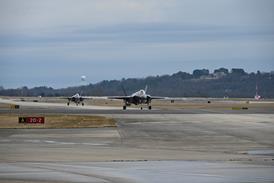The airline campaign to cut airport and air traffic service charges has been a bruising experience, but there are encouraging signs that it has opened up a more fundamental debate over the relationship between airlines and their infrastructure providers
The airline community has spent much of the past couple of years cheering IATA in its efforts to prise cost savings from airports and air traffic service (ATS) providers. The campaign has been successful in its own terms, measured by headlines and hard dollar savings. Along the way it also created some deep fissures in the relationship between airlines and their infrastructure providers. But the bruising experience will have been worthwhile if it provokes the two to get down to a more open debate about the future relationship of airlines with their infrastructure providers.
IATA makes no excuses for its strident approach. As one executive notes: "When you start a campaign like this you don't get people's attention with quiet diplomacy." Along the way IATA reckons that the industry won some $630 million worth of savings last year in airport and ATS charges, either through reductions in charges or planned fee increases.
Such hard cash savings are welcome, but better are the encouraging first signs that airports and ATS are becoming more fully engaged in the debate over the future shape of the air transport business. It is a debate that the traditional carriers have already been forced to face. Not so long ago the bulk of the airlines themselves looked more like national institutions than agile commercial enterprises. But the twin forces of growing consumer power and open markets have completely changed that world.
Having come under intense pressure from their own customers to change, airlines now want to pass on that pressure to their suppliers. But up until now, airports and ATS providers have not been under the same market pressure. The challenge ahead is to make that switch from being a national infrastructure provider to a true service provider.
For many, this kind of dramatic shift will require a massive change in mindset. "Some are with you 100%," says Tom Windmuller, member & government relations at IATA. "But there are some dinosaurs that are never going to get there. The challenge is to take the 80% that are in the middle and move them to where the progressive thinkers are."
Progress is being made, albeit in patches, with the pioneers embarking on cost-efficiency programmes and adopting a customer-focused ethos. Consumer power is more directly affecting airports than ever before. And it is being driven by the emergence of the low-cost sector, just as it is for the legacy carriers. In Europe and Asia-Pacific there is a rush to capture low-cost growth by offering low-cost terminals. It may not be long before there is a distinction between legacy and low-cost airports.
Even with ATS there appears a genuine desire to move away from their utility mentality to a more co-operative approach. This enthusiasm was evident at the recent annual general meeting in Brisbane of the Civil Air Navigation Services Organisation, and appears strongest among those ATS bodies that have moved farthest away from government. But, as one official pointedly asked, when a government-operated ATS body can simply pass on its costs in the form of higher charges - what is the incentive to change? The simple answer is that the cost-recovery model is time-limited. And the debate over an alternative is now in full flow.
Eurocontrol is working to establish a pan-European cost-efficiency target for the region's ATS providers, which demonstrates the institutional desire for change. IATA's latest campaign is to work with individual providers, first in Europe and later beyond, to take this further and encourage them to define their own specific targets.
IATA and the airlines are now working more constructively with ACI and the airports and both have agreed that it is time to tone down the "name-calling". There is, for example, a joint initiative to examine "good practice" airline-airport charging models where the relationship appears to be working. Such examples are still relatively scarce - multi-year deals between carriers and airports at Copenhagen, Frankfurt and Melbourne are often cited.
The process needs enlightened regulators too. If airports, or for that matter ATS, are to have more commercial freedom, then the regulatory environment needs to shift too. In the USA, airports are calling for such deregulation. They acknowledge that this is a way to recognise their curious hybrid nature as both a public facility and as an enterprise. In the UK, the regulators themselves are recommending a lighter touch. The ideal is to see airlines and airports draw up a joint business plan, including charging agreements, and only then to take that to the regulator for approval. There are no ready-made templates for how the relationship may evolve, but recognising the need for change and exploring the options is a huge first step.
Source: Airline Business























